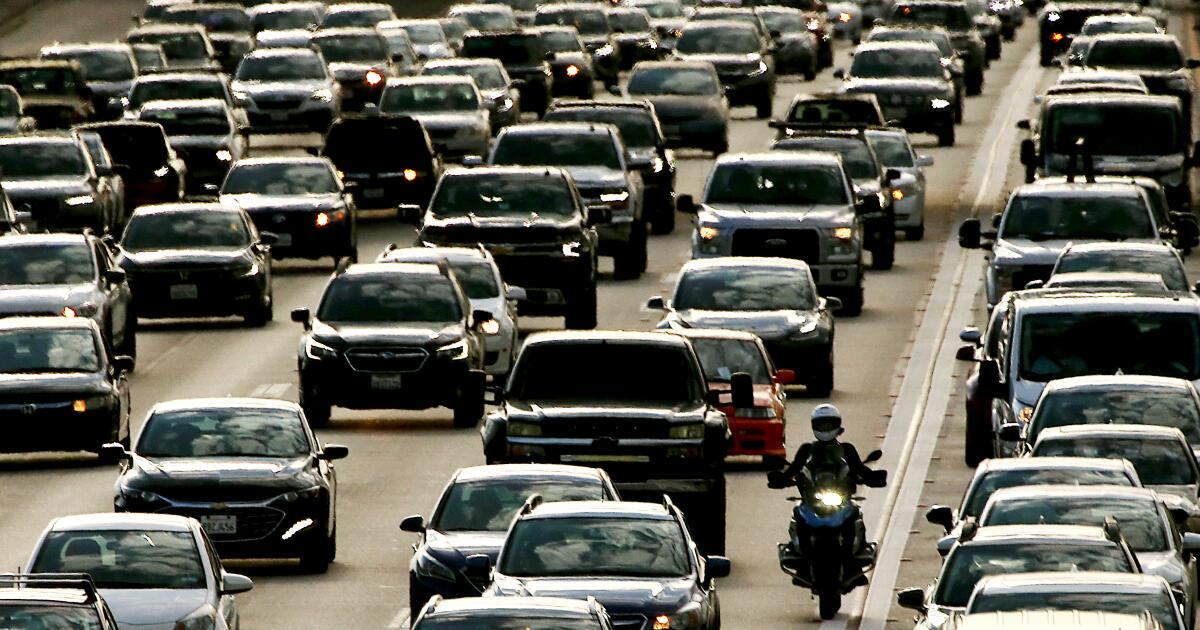California greenhouse gas emissions dropped about 2.4% in 2022 — an encouraging sign that the state’s carbon footprint is decreasing once again, even as the economy rebounds from the COVID-19 pandemic, according to state officials.
The California Air Resources Board announced Friday that planet-warming gas emissions shrank by about 9.3 million metric tons of carbon dioxide in 2022 compared to 2021 — the equivalent of removing 2.2 million gasoline-powered vehicles from the road for a year.
More than half of those reductions came from the transportation sector as California drivers bought more electric vehicles and less gasoline. Also, cargo trucks that ferry goods from ports and rail yards are increasingly running on crop-based biofuels, instead of conventional diesel fuel.
“The numbers are clear: our world-leading regulations are reducing emissions, spurring innovation, and bringing us closer to achieving our climate goals,” Air Resources Board chair Liane Randolph said in a statement. “A future with clean air and a vibrant economy is possible and California is leading the way.”
The level of greenhouse gas emissions in 2022 was the lowest since 2020, a year marred by the pandemic, economic shutdowns and supply chain disruptions. In 2021, California’s emissions rose by about 3.4% due to a surge in consumerism and the reawakening of the economy following the development of a vaccine.
The decline in greenhouse gas emissions in 2022 demonstrates that the state is continuing to lower carbon emissions while growing the economy, officials said. From 2000 to 2022, statewide emissions have decreased by 20% while the gross domestic product (the value of goods and services) has increased by 78%.
“One of the things that I think is important to observe is that there was a pretty dramatic decrease during COVID in 2020 and a bit of a rebound [in 2021],” said Steven Cliff, the executive officer of the state Air Resources Board. We did not see that rebound continue. Thankfully. You know, the policies are working. And in fact, here in ’22 we’re really close to where we were in in 2020 when that really dramatic decrease was observed.
With the world’s fifth-largest economy and the nation’s largest population, California has made substantial strides in transitioning away from fossil fuels. But questions still abound over whether the state will achieve its ambitious climate goals, including its 2030 target of reducing its carbon footprint by 40% compared to 1990 levels.
To meet that target, Californians would need to eliminate an additional 113 million metric tons of carbon dioxide per year — on par with the emissions from 29 coal-fired power plants.
Some experts have expressed skepticism about reaching that mark, but Cliff said he is optimistic.
“The goal here is to hit the targets that are mandated by law [and] accelerate those to hit the long-term goals, obviously, as fast as we can possibly do it,” Cliff said.
“We have a lot of policies on the books that are just starting to be binding, and that is why I would expect to see reductions accelerate over time towards that target,” Cliff added. “So I think it looks like we’re on track.”
Transportation continues to be the largest source of state emissions, with passenger vehicles contributing 27% of the state’s planet-warming gases. But there has been tremendous progress with electric vehicle sales. In 2022, more than 300,000 zero-emission or plug-in hybrid vehicles were sold in California, making up nearly 20% of all light-duty vehicle sales.
The progress is encouraging as that share of car sales increased 2023, when 1 in 4 cars bought in California are zero-emission.
California continues to expand the role of renewable energy in its electricity grid. Around 50% of the state’s power comes from wind, solar or zero-emission nuclear power.
The state’s industrial emissions also dipped 2% to the lowest level since greenhouse gas estimates began in 2000, largely driven by continued declines in oil production.
Methane, a heat-trapping gas that warms the planet 80 times faster than carbon dioxide, has risen over the past two decades from the state’s dairy farms, landfills and pipeline leaks. Officials say agricultural and waste emissions fell slightly in 2022 with the deployment of cow manure storehouses and reductions in solid waste, both of which are intended to reduce methane emissions.
But greenhouse gas emissions from commercial and residential buildings have risen as more workers return to large office buildings that require heating and cooling. As a result, emissions of hydrofluorocarbons — a high-warming gas — have spiked.
